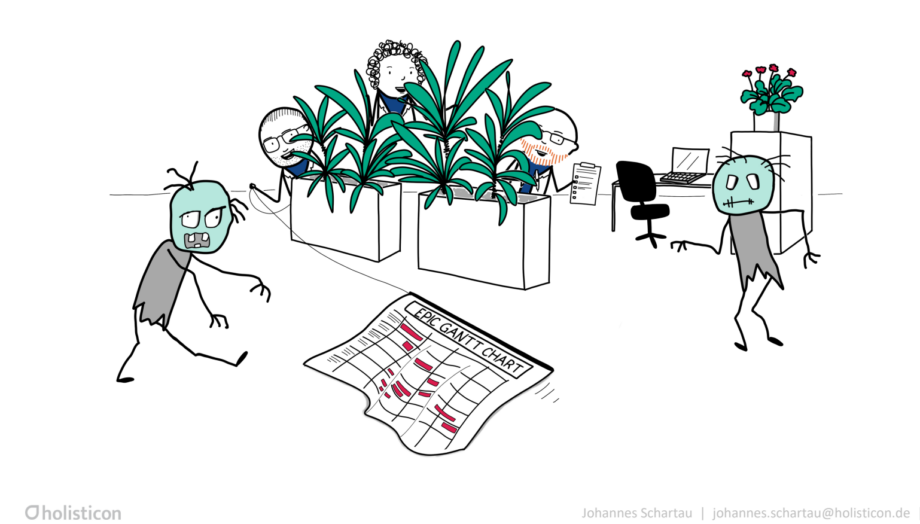On July 12th, our Agile Kitchen was bursting with activity again, as Johannes Schartau came to talk about Zombie Scrum during an online interactive session!
But what is this Zombie Scrum? What have we learned in our Kitchen from Johannes, an Agile Coach, international speaker, complexity and integral thinker, Liberating Structures user, and Zombie Scrum fighter? He is also the co-author of the “Zombie Scrum Survival Guide” together with Christiaan Verwijs and Barry Overeem.

The Zombie Scrum model is based on a survey done by almost 15.000 people and that is being finetuned continuously with new data. The idea behind it was to add value to the Agile community. Despite all the interesting books and cool new ideas for doing Scrum and Agile well, reality was different and they noticed many bad examples in real life.
So they started doing some experiments to link all the symptoms to the core problem of what they call Zombie Scrum: the discrepancy between what scrum tries and promises to deliver and how it is actually used in real life.
Take a step back: what is Scrum?
Scrum is a lightweight framework that helps people, teams and organisations generate value through adaptive solutions for complex problems.
Please be aware that there is a difference between complicated challenges and complex challenges.
Complicated challenges are difficult challenges that can be solved by analysing and designing a plan to solve the challenge. The road to success is a number of actions linked together as cause and effect relationships.
Complex problems are problems where success isn’t clear. We have a vague idea what success means, but it crystalizes more during the journey of reaching it. There is no way to plan from start to finish, but we rather need to take individual steps, reassess, reorient and take the next step. We need to gain experience and create information to learn in order to achieve success. This also includes taking a step back every now and then. Scrum is designed to solve these complex problems. The process behind this is a loop of inspection, adaptation and transparency.

Zombie Scrum
We learned that the Zombie Scrum model describes four dimensions in order to be successful:
- Build what stakeholders need
- Ship it fast
- Improve Continuously
- Self-Organise
Dimension 1: Build what stakeholders need
Often we see a separation between a business entity and an IT entity within an organisation. The entities behave in an isolated way and typically communicate with contracts and reports. Ideas are translated numerous times before the Scrum team hears it. This huge distance implies communication errors and misinterpretations.
An interesting idea is the customer distance metric where you track down your finished work towards the origin of the original idea. It can go from PO to a business unit and then maybe to a customer or a user etc. This metric makes these paths transparent and shows how far on average the real customers are. We can use this visualisation to start talking about this distance and understanding the difficulties it imposes or the opportunities we are missing.
Dimension 2: Ship it Fast
Shipping a product fast means validating your assumptions. Often Scrum teams run a large number of sprints before really releasing their product. Releasing the product seems difficult and cumbersome. After a team finishes their work, often a lot of work still needs to be done before it actually can be put in production such as installations, integrations, testing, validation etc. In Zombie Scrum, the preparation time before a sprint and after the sprint is rather long making the entire lead time of an item much longer that the cycle time of the sprint. In Healthy Scrum, the lead time lies much closer to the cycle time, because the preparation time is limited to the absolute necessity and the time after the sprint is minimised by finishing as much as possible during the sprint.
Dimension 3: Improve Continuously
Often, Zombie Scrum teams go through the motions of Scrum, they execute the prescribed events, improving small problems, but they fail to change or improve big topics.
Immature Scrum teams spend a lot of time and effort understanding the basics of Scrum and how to work as a Scrum Team. Less and less time is invested in improving engineering practices, let alone looking at adjacent processes or organisational processes. When the Scrum experience grows, teams start spending more time on the latter items and less on the first, as described by Dominik Maximini in The Impediment Pyramid, where he describes the impediments that Scrum masters encounter with their Scrum Teams and how to overcome them as they get more experienced.
An important concept in continuous improvement is double-loop learning, an educational concept created by Chris Argyris that teaches people to think more deeply about their own assumptions and beliefs. So when validating actions of a team, it is important to not only try to fix eventual problems, but to first step back to evaluate the reasons for which you do the things you do, before changing them.
Dimension 4: Self-Organise
In the agile community, self-organisation seems to be logical and needed. We believe that it increases flexibility and the speed of solving problems. It exploits the power of autonomy where people and teams truly get the accountability to make important decisions about the product they make.

It is clear to say that we got many interesting insights from this Agile Kitchen session with Johannes!
If you were unable to attend and if you want to know more about the Zombie Scrum Survival guide, check out Johannes’ profile on LinkedIn!
Are you curious about our Agile Kitchen sessions? Please check out our Agile Kitchen calendar to subscribe to our next sessions!


